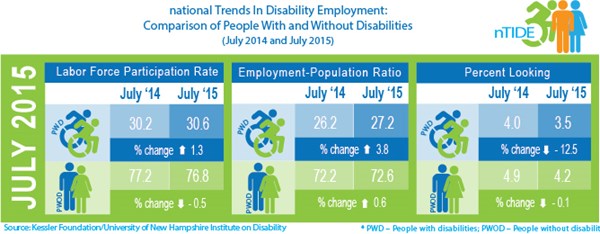WEST ORANGE, N.J., Aug. 7, 2015 (GLOBE NEWSWIRE) -- More Americans with disabilities continue to find jobs, while employment holds steady for the general population, according to today's National Trends in Disability Employment – Monthly Update (nTIDE), issued by Kessler Foundation and University of New Hampshire's Institute on Disability (UNH-IOD). The transition from school to work, however, remains challenging for young people with disabilities. College to career programs are helping to overcome this barrier by preparing students for the workplace and facilitating the matching of students with disabilities with employers.
In the Bureau of Labor Statistics' Jobs Report released Friday, August 7, the employment-to-population ratio for working-age people with disabilities increased from 26.2 percent in July 2014 to 27.2 percent in July 2015 (up 3.8 percent; 1 percentage point). For working-age people without disabilities, the employment-to-population ratio also increased slightly from 72.2 percent in July 2014 to 72.6 percent in July 2015 (up 0.6 percent; 0.4 percentage points). The employment-to-population ratio, a key indicator, reflects the percentage of people who are working relative to the total population (the number of people working divided by the number of people in the total population multiplied by 100). In comparison to July 2014, 169,000 more Americans with disabilities are in the workforce.
"The improvement in the employment situation for people with disabilities continues to outstrip improvements made by people without disabilities," according to John O'Neill, Ph.D., director of employment and disability research at Kessler Foundation. "This trend has been seen for the last 10 months and is exceptionally good news because it occurred in July, the month that we celebrated the twenty-fifth anniversary of the Americans Disabilities Act (ADA)."
For people with disabilities, the labor force participation rate also increased from 30.2 percent in July 2014 to 30.6 percent in July 2015 (up 1.3 percent; 0.4 percentage points). For people without disabilities, the labor force participation rate decreased slightly from 77.2 percent in July 2014 to 76.8 percent in July 2015 (down 0.5 percent; 0.4 percentage points). The labor force participation rate is the percentage of the population that is working or actively looking for work.
"Employment-wise, this year is turning out to be a very good year for people with disabilities," said Andrew J. Houtenville, Ph.D., associate professor of economics and research director at UNH-IOD. "They are overcoming losses that occurred in 2014. The employment trend for people with disabilities was relatively flat from 2011 to 2013. We are eager to see if the trend in the coming months shoots past the 2011 to 2013 levels."
Social Security data indicate that half of college graduates with disabilities are unemployed within five years of graduation. In California, Bridging the Gap from College to Careers (C2C) program is changing those odds for students with disabilities at San Diego State, California State University and the University of California Berkeley. The C2C program comprises a Professional Development and Disability course, mentoring, internships, job placement services and a C2C LinkedIn Alumni Group. The program, which is supported by Kessler Foundation, reports a 67 percent placement rate at an annual average salary of $62,000.
"Talented students are taking advantage of the comprehensive services offered by the C2C Program and transitioning from college to careers," said Elaine E. Katz, MS, CCC-SLP, senior vice president of grants and communications at Kessler Foundation. "This program helps people with disabilities overcome the negative attitudes of employers and compete successfully in the workplace." The C2C transition model is under consideration for replication at colleges in Florida, New Jersey and Wisconsin, and has garnered the attention of organizations in England, Japan and Germany.
In July 2015, among workers ages 16-64, the 4,235,000 workers with disabilities represented 3.0 percent of the total 141,340,000 workers in the U.S.
"The statistics in nTIDE are not seasonally adjusted," noted Dr. O'Neill. "Because disability employment data have been collected for so few years, more time is needed for seasonal trends to become evident."
The next nTIDE will be issued on Friday, September 4, 2015.
NOTE: The statistics in the National Trends in Disability Employment – Update are based on Bureau of Labor Statistics numbers, but are NOT identical. They have been customized by the University of New Hampshire to efficiently combine the statistics for men and women of working age (16 to 64).
nTIDE is funded, in part, by grants from the National Institute on Disability, Independent Living and Rehabilitation Research (NIDILRR) (H133B130015 & H133B120005) and Kessler Foundation.
About Kessler Foundation
Kessler Foundation, a major nonprofit organization in the field of disability, is a global leader in rehabilitation research that seeks to improve cognition, mobility and long-term outcomes, including employment, for people with neurological disabilities caused by diseases and injuries of the brain and spinal cord. Kessler Foundation leads the nation in funding innovative programs that expand opportunities for employment for people with disabilities. For more information, visit KesslerFoundation.org.
About the Institute on Disability at the University of New Hampshire
The Institute on Disability (IOD) at the University of New Hampshire (UNH) was established in 1987 to provide a coherent university-based focus for the improvement of knowledge, policies, and practices related to the lives of persons with disabilities and their families. For information on the NIDILRR-funded Employment Policy and Measurement Rehabilitation Research and Training Center, visit http://www.ResearchonDisability.org.
For more information, or to interview an expert, contact:
Lauren Scrivo, 973.768.6583, LScrivo@KesslerFoundation.org
A photo accompanying this release is available at: http://www.globenewswire.com/newsroom/prs/?pkgid=35011
